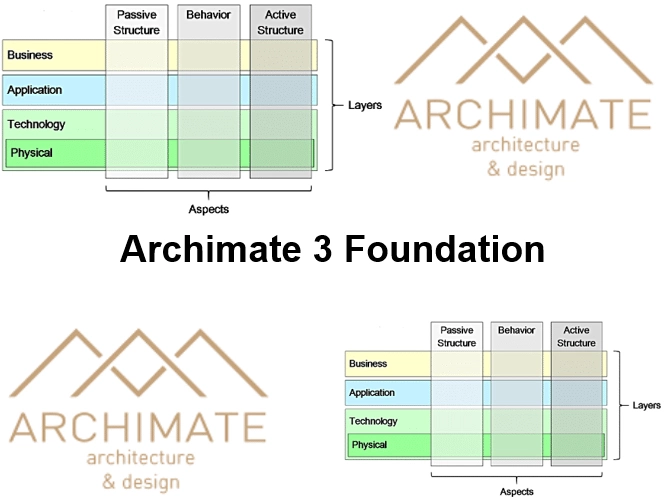- Leren door doen
- Trainers met praktijkervaring
- Klassikale trainingen
- Gedetailleerd cursusmateriaal
- Duidelijke inhoudsbeschrijving
- Maatwerk inhoud mogelijk
- Trainingen die doorgaan
- Kleine groepen
In de cursus ArchiMate 3 Foundation van SpiralTrain krijgen de deelnemers een sterke basis in architectuur modellering met behulp van de ArchiMate taal. De cursus omvat praktische oefeningen, casestudies en examenvoorbereiding om de vaardigheid van de deelnemers bij het maken van architectuur modellen te vergroten.
De cursus Archimate 3 Foundation gaat van start met een overzicht van het belang van Enterprise Architectuur in organisaties. Daarbij wordt ingegaan op standaarden op het gebied van EA Architectuur Modellering en de rol van Archimate en tools daarin.
Aandacht wordt besteed aan de hierarchische structuur van Archimate waarbij een model beschouwd wordt als een collectie van elementen en relaties. Ook het onderscheid tussen behavior, structural, motivation en composite elementen komt dan aan bod.
Vervolgens wordt ingegaan op Business Modeling in Archimate waarbij de operationele organisatie van een onderneming in een technologie onafhankelijke manier wordt beschreven. Hierbij worden Business Functies, Processes, Services en Objects behandeld evenals Interactions and Events.
Eveneens komt Application Architectuur aan de orde waarbij een subset van de ArchiMate elements zoals Application Component, Application Service en Application Interface worden gebruikt. Ook passeert de revue wordt hoe het Layered View de context van een applicatie zichtbaar maakt.
Aan bod komt ook het modelleren van de Technology Architecture met Technology Layer elementen zoals Technology Services, Events en Interfaces. Zowel Active als Passive Structure elementen spelen daarbij een rol.
Eveneens onderdeel van de cursus Archimate 3 Foundation is Strategy Modeling in Strategy Layer. De elementen Resource, Capability en Course of Action dienen voor het modelleren de strategische doelen van de onderneming,
Dan wordt implementation migration planning besproken met als viewpoint applicaties en projecten te relateren aan de delen van de architecture die ze implementeren.
Tot slot worden ingegaan op hoe je kunt certificeren voor Archimate 3, wat de examen eisen zijn. Ook tips en tricks voor het behalen van het examen worden dan besproken.
De cursus Archimate 3 Foundation is bedoeld voor enterprise architecten die de Archimate 3 taal willen gebruiken bij het ontwerp van een Enterprise Architectuur.
Algemene kennis van Enterprise Architectuur en het modelleren daarvan is wenselijk om aan deze cursus te kunnen deelnemen.
De cursus Archimate 3 Foundation heeft een hands-on karakter. Theorie aan de hand van presentaties wordt afgewisseld met practische opdrachten voor het maken van Enterprise Architectuur modellen in Sparx Systems Enterprise Architect.
De deelnemers krijgen na het goed doorlopen van de cursus een certificaat van deelname aan de cursus Archimate 3 Foundation.

Module 1 : Intro EA |
Module 2 : ArchiMate Concepts |
Module 3 : Business Modeling |
|
What is Enterprise Architecture Importance of EA in Organizations EA Frameworks and Standards EA in Decision-Making Introduction to ArchiMate Evolution of ArchiMate ArchiMate's Role in EA ArchiMate Certification ArchiMate Modeling Tools Elements and Notation Relationships in ArchiMate UML Modeling Standard Sparx Enterprise Architect |
ArchiMate Layers Business Layer Application Layer Technology Layer ArchiMate Aspects Active Structure Passive Structure Data and Service Concepts Actor and Role Concepts Business Process Concepts Function Concepts Technology Service Relationships and Connectors |
Business Layer Overview Actors and Roles Business Collaboration Business Interface Business Function Business Process Interactions and Events Business Services Business Objects Business Process Modeling Services and Relationships Business Capabilities Archimate Meta Model |
Module 4 : Application Modeling |
Module 5 : Technology Modeling |
Module 6 : Strategy Modeling |
|
Application Layer Overview Application Components Application Collaborations Interface and Functions Application Services Application Processes Interactions and Events Data Objects Application Artifacts Services and Relationships Integration and Interfaces |
Technology Layer Overview Diagram Types Technology Collaborations Interfaces and Functions Service and Processes Technology Interactions Technology Object Technology Artifacts Services and Relationships Infrastructure Considerations Deployment Considerations |
Motivation and Strategy Concepts Stakeholders and Concerns Sequence Diagrams Goals, Drivers, and Objectives Assessment and Gap Analysis Principles and Requirements Motivation Elements and Notation Strategy Mapping and Alignment Strategy Modeling Best Practices Strategic Planning and Execution Legends and Grouping |
Module 7 : Implementation Planning |
Module 8 : ArchiMate in Practice |
Module 9 : Archimate Certification |
|
Implementation and Migration Planning Implementations Project and Roadmap Views Work Packages and Dependencies Implementation Elements Transition Planning Transition Execution Gap Analysis Impact Assessment Agile and DevOps in Architecture |
ArchiMate in Real-World Projects Industry-specific Use Cases ArchiMate Modeling Patterns Tips for Effective Modeling Collaboration and Version Control Reporting and Documentation ArchiMate Tools and Ecosystem ArchiMate and Other EA Frameworks Certification Preparation ArchiMate Future Trends |
Certification Overview Abstracting Elements EAI Patterns Information Resources Views and Maps Aspect Orientation ArchiMate Exam Objectives Exam Preparation Tips Sample Questions and Mock Exams Test-Taking Strategies |
